Homemade crescent rolls are buttery, soft rolls that are so delicious and easy to make from scratch. There’s no denying Pillsbury crescent rolls are convenient, but learning how to make your own from scratch is worth it! You can also use the dough just like the pre-made kind, using it to make all your favorite breakfasts, appetizers, and snacks.
If you’re apprehensive about whipping up a batch of these fluffy crescent rolls from scratch, my tried and true recipe is foolproof! All you need are 8 basic ingredients (including water!) to make a batch. A stand mixer makes it even easier, but you can also knead the soft dough by hand if you don’t have one. For more homemade bread recipes, check out my French bread, classic white bread, and crusty artisan bread next!
Ingredients

These are the key ingredients needed to get started. You can find the full list of ingredients in the crescent roll recipe card.
Warm water and whole milk — “warm” is the operative word here. Ideally, these liquid ingredients should be in the range of 110°-120°F to create an optimal environment for the yeast to thrive. If it’s any hotter, you can risk killing the yeast before it’s activated.
Granulated sugar — a little bit of white sugar is important for activating the yeast and helping it stay active during the rise. It also adds some depth of flavor to the rolls, but don’t worry, they won’t taste sweet!
Active dry yeast — this is what causes our crescent roll dough to puff up. Make sure your yeast is active by proofing it before you start. If it doesn’t foam after 10 minutes, you should start over with a new packet!
Unsalted butter and kosher salt — starting with unsalted butter and adding your own salt to the dough gives you the best control over the end results. I like to use salted butter to brush the crescent roll tops after they come out of the oven for a richer flavor. The unsalted butter needs to be softened, so if you don’t have time to let it sit out, use one of my tricks to soften butter quickly!
Large eggs — as a general rule, when a baking recipe calls for eggs, the size matters. Small, medium, or jumbo eggs are much different in size, and this will affect how dry or wet the dough turns out.
All-purpose flour — plain white flour is all you need! This lower protein flour (around 10-12%) is perfect for creating the classic fluffy texture crescent rolls are known for. A bread flour will make the rolls extra chewy, which is fine to substitute if that’s what you prefer.

Crescent Rolls Recipe
Video
Equipment
- Electric stand mixer
- Mixing Bowls
- Baking Sheet
Ingredients
- ⅓ cup warm water 110°-120°F, (80ml)
- 5 teaspoon sugar divided
- 2¼ teaspoons dry active yeast (7g/.25-ounce packet)
- ⅔ cup warm whole milk 110°-120°F, (160ml)
- ½ cup unsalted butter room temperature, (113g)
- 2 large eggs room temperature
- 4 to 4½ cups all-purpose flour divided, (480g to 510g)
- 1½ teaspoons kosher salt
- 2 tablespoons melted butter
Instructions
- In a large mixing bowl or the bowl of a stand mixer, combine warm water, 1 teaspoon sugar, and yeast. Let stand until foamy, about 5 minutes.
- In this order, add the remaining 4 teaspoons sugar, whole milk, butter, and eggs. Add 2 cups (240g) of flour and the salt. Mix with the paddle attachment or a wooden spoon until well combined.
- Switch to the dough hook and turn the mixer on low speed, or continue mixing by hand with the wooden spoon. Add the remaining flour ½ cup (60g) at a time, kneading until a soft dough ball forms and starts to pull away from the sides of the bowl, about 15 minutes.
- Shape the dough into a ball and place in a large, lightly oiled bowl. Cover and let rise in a warm place until doubled in size, 45 minutes.
- Gently punch down the risen dough and divide it in half. On a lightly floured surface, shape each half into a ball and roll into a 12-inch circle. Using a pizza cutter or pastry wheel, cut the circle into 12 wedges.
- Starting at the wide end, roll each wedge up to the point to form the crescent roll shape.
- Line a baking sheet with parchment paper. Place crescent rolls on the baking sheet about 2 inches apart. Loosely cover and let rise until puffed, about 30 minutes.
- Meanwhile, preheat the oven to 400F.
- Bake for 10 to 12 minutes or until golden brown. Immediately brush with melted butter and serve warm.
Notes
- Add the salt last. Salt shouldn’t come in direct contact with the bloomed yeast because it can kill the yeast or slow down its ability to make the dough rise. I usually add the flour and then the other ingredients, leaving the salt last, to avoid any potential issues.
- Add more flour if needed. Depending on the flour brand and exact ingredient measurements, you may need more or less flour for your crescent roll dough, which is why I give a range. Start with a smaller amount so you can add more if the dough is still sticky. It’s impossible to take flour out, but it’s easy to add more if needed, so start with less!
Nutrition
How To Make Crescent Rolls

1. In a large bowl or stand mixer, proof the yeast by mixing warm water, 1 teaspoon sugar, and the yeast together. Let it sit until foam begins to gather on top.
2. Once foamy, add the rest of the sugar, milk, butter, and eggs. Mix in 2 cups flour and salt until combined.
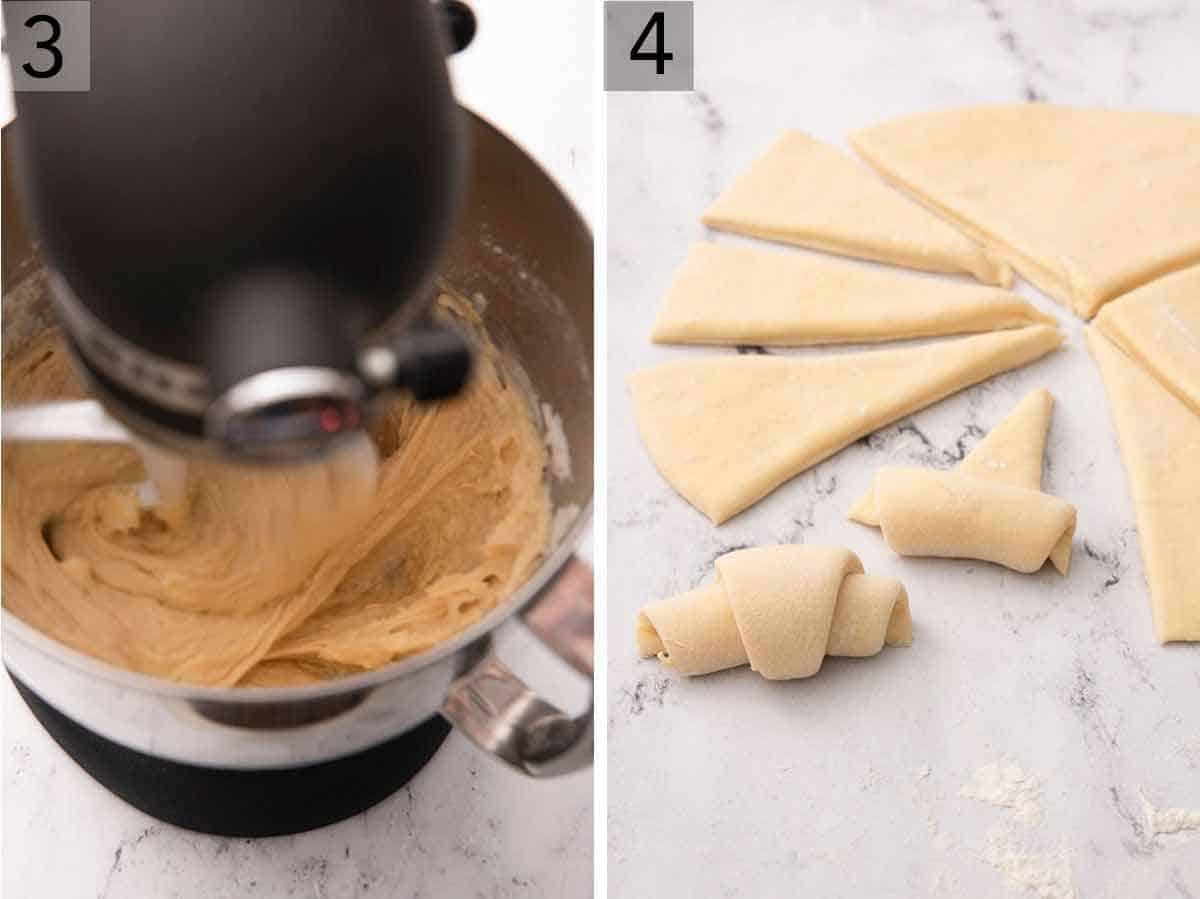
3. Use a dough hook or continue by hand, gradually adding the remaining flour until the dough forms a soft ball and pulls away from the sides of the bowl. Form dough into a ball, place it in a greased bowl, cover with plastic wrap, and let rise in a warm place until doubled in size.
4. Punch down the crescent roll dough, divide it in half on a lightly floured surface, and roll each half into a 12-inch circle. Cut each circle into 12 wedges with a pizza cutter. Roll up each wedge starting from the wide end to form the classic crescent shape.
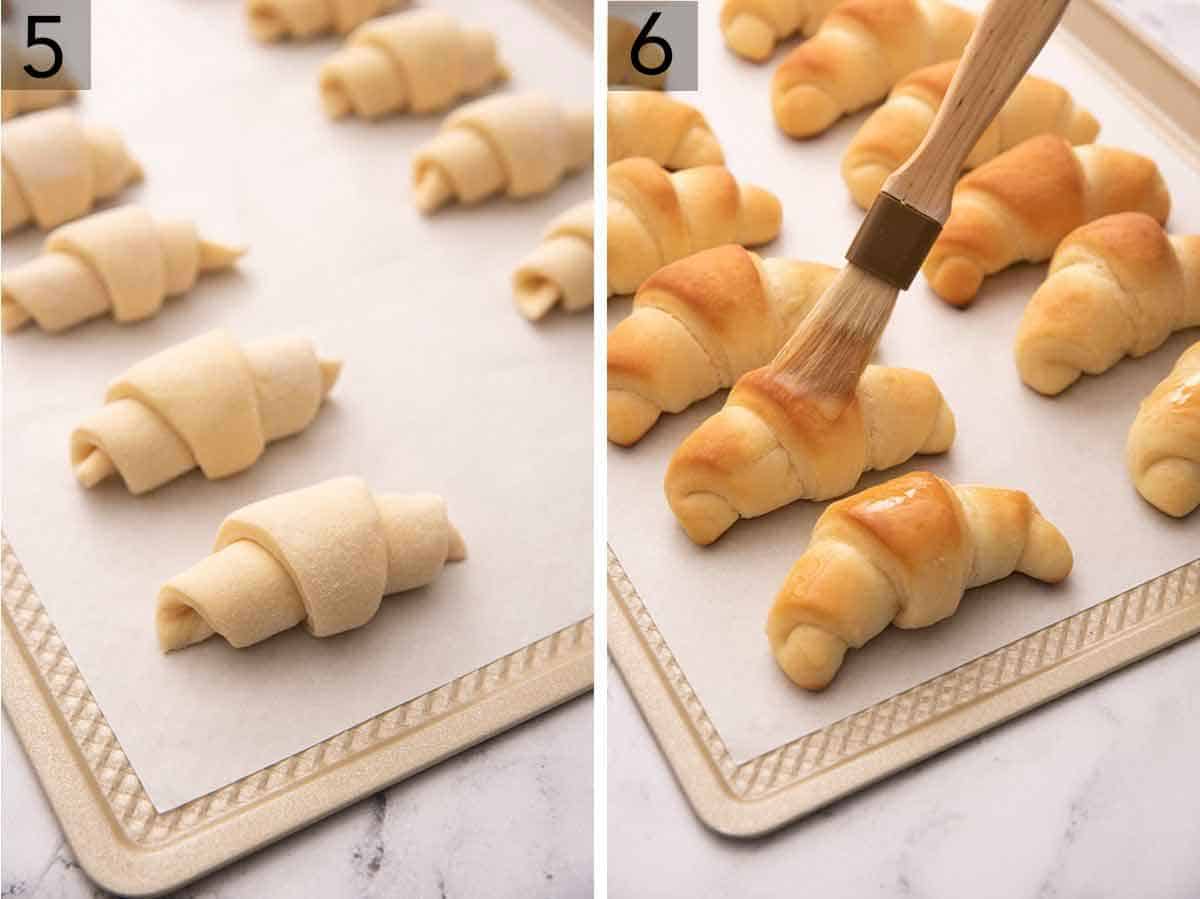
5. Place crescents on a parchment paper-lined baking sheet, cover loosely, and let rise until puffed, about 30 minutes.
6. In the meantime, preheat the oven to 400°F. Bake crescents for 10-12 minutes until golden. Brush the hot rolls with melted butter before serving.
Are Crescent Rolls And Croissants The Same Thing?
No, they are quite different in texture and process. While they are shaped similarly, croissants are made from a yeasted laminated dough (similar to puff pastry)—that means it’s been folded and rolled out with a sheet of butter, which is what creates all those flaky layers.
Crescent rolls are made with a yeasted enriched dough—similar to challah or brioche. Enriched dough means that it is made with fat-containing ingredients like milk, eggs, and butter fully incorporated into the dough.
How To Use Crescent Rolls
I serve them like dinner rolls with honey butter, turn them into breakfast sandwiches stuffed with eggs and cheese, or alongside slices of my favorite breakfast casserole. You can also use this from-scratch recipe in place of refrigerated tubes of crescent roll dough! Stuff them with cocktail sausages to make pigs in a blanket, cut the dough into strips to make delicious garlic knots, or use sheets of the dough to make my cinnamon-sugar-topped sopapilla cheesecake.
Variations
There are plenty of ways to make this crescent roll recipe your own!
- Add 2 tablespoons of minced fresh herbs or 1 tablespoon of dried herbs to the dough.
- Use melted garlic butter to brush the tops for a savory spin.
- Turn them into a sweet breakfast roll by sprinkling cinnamon sugar on top before baking, lightly caramelizing the tops.

Make Ahead Tips
If you’re working ahead, you have two options. For overnight crescent rolls, shape them, cover the baking sheets with plastic wrap, and chill them overnight, skipping the second rise. (They will continue to rise in the fridge, just more slowly under the cold temperatures.) When you’re ready to bake, pull them from the fridge and let them set at room temp for 30 minutes while your oven preheats.
Pro Tips For Making This Recipe
- Weigh the dry ingredients. When it comes to baking, precision is the name of the game. Whenever possible, you should use a kitchen scale for weight measurements instead of volume measurements. You can accidentally pack in an extra 20-40 grams of flour if you scoop directly from your container. If you don’t have a scale, fluff up the flour and spoon it into your measuring cup, then level it off with the flat edge of a knife.
- Ingredient temperature matters. In order to properly activate the yeast, make sure the temperature of the liquid ingredients doesn’t exceed 120ºF. Similarly, we don’t want to bring the temperature too low when we make additions, or we can slow down the dough’s rise. Make sure the eggs and butter are at room temperature.
- Don’t have a stand mixer? You can mix the dough together with a wooden spoon to start, then turn it out on a floured surface and knead it by hand for 5 to 10 minutes or until it is smooth.
- Watch the dough, not the clock. The rise time for your dough will depend on multiple factors, particularly the temperature of your ingredients and the ambient temperature of the room you’re working in. Colder temperatures mean slower rise times and warmer temperatures mean faster rise times. The dough is ready when it’s poofed and doubled in size, and the dough springs back slowly after gently poking it with your finger.

Frequently Asked Questions
Allow any leftover rolls to cool completely to room temperature, then transfer to an airtight container. They should keep well for up to 3 days on the counter. For longer storage, transfer cooled leftovers to a freezer bag and freeze for up to a month, then reheat them in the toaster oven as needed.
You sure can! Shape the crescents as instructed and let them rise for 20 minutes. Then, freeze them on the sheet pan in a single layer before transferring them to an airtight container or freezer bag. The night before you’re planning on serving them, arrange them on a sheet tray, lightly cover them, and defrost them in the fridge overnight. Let them sit at room temperature for 30 minutes while the oven heats up before baking.
No, not really. Crescent dough is fluffy and buttery but isn’t laminated or flaky like puff pastry dough. The texture is more similar to a yeasted dinner roll.
If you’ve tried this Crescent Rolls recipe, then don’t forget to rate it and let me know how you got on in the comments below. I love hearing from you!




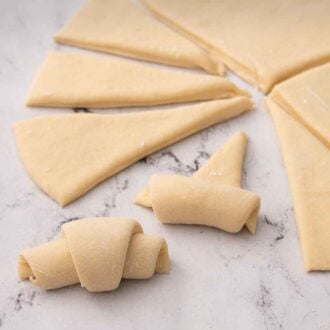
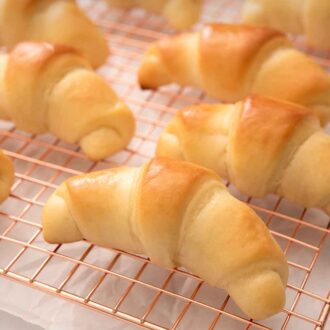
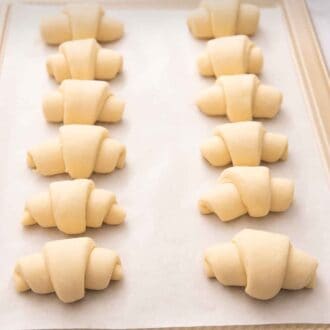
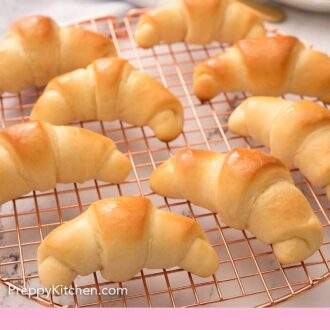




Leave a Reply